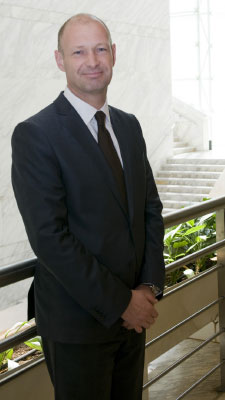
Jost Lammers, CEO Budapest Airport: “The BUD brand has taken on the mantle of customer champion by investing so much in research, digital services and, of course, marketing. As long as passengers appreciate this, we must be doing something right.”
The Budapest Airport vision is clear – to be the best airport in both its peer group and region. It is a philosophy ingrained into each of its business and corporate units, and embodied by the progressive vision of the airport’s CEO Jost Lammers. He discussed the developments that have been central to Budapest Airport’s continued growth, and led to it being commended in the ‘5-10 million passenger’ category at this year’s ACI EUROPE Best Airport Awards, with Samantha Jenkins.
Budapest Airport is the most dynamically-growing in Central and Eastern Europe, and 2015 has been a year of success on many levels. Its recovery since the collapse of national carrier Malév in 2012 has been impressive. Indeed, in commending Budapest Airport (BUD) in the ‘5-10 million passenger’ category at this year’s ACI EUROPE Best Airport Awards, the judges praised its “dynamic reaction to difficult circumstances” and “already-recognised and awarded quality in ASQ”.
The airport’s CEO Jost Lammers is justifiably proud of BUD’s successes and the role of the entire team in delivering these. “It is teamwork, teamwork, teamwork. Without this, a business cannot fulfil its objectives,” he asserted. “After the collapse of your largest customer, you need to stand up and be counted, and the BUD brand has taken on the mantle of customer champion by investing so much in research, digital services and, of course, marketing. As long as passengers appreciate this, we must be doing something right.”
Building on a record year in 2014, in which it handled 9.1 million passengers, results for the first half of 2015 show an impressive 11.8% year-on-year growth, putting BUD on track to handle about 10 million passengers this year.
This growth has exceeded expectations and demonstrates the importance of Budapest as a destination for both business and leisure customers. “On the new airline/new route front, we are firmly focused on bringing new players to the market, as evidenced by Air Transat, Air China, and Emirates in the last few months,” Lammers explained. “The biggest white spots for us are Southern France, Southern Spain, the US, and Bangkok, Tokyo and Seoul in Asia. There is proven demand in these markets and our published incentive schemes support airlines willing to invest in flying to Budapest.”
The passenger experience is front and centre of Lammers’ vision for BUD. Over €340 million has been invested in the airport’s redevelopment in recent years, including the new SkyCourt terminal which opened in 2011. Recent enhancements include changing the sliding automatic doors in Terminal 2A to revolving doors to make the insulation better in both summer and winter; the parking offer has been upgraded, with online discounts boosting occupancy by 40%; and security screening equipment has been updated. “We have also introduced passenger support assistants in the check in area,” Lammers added. “On the airside, we opened ‘The Terrace’, which is a go-to location for travellers to enjoy a rooftop snack or drink while watching the aircraft on the apron. In cooperation with our lounge operating partners, I am also pleased to say that two refurbished lounges have enhanced the passenger experience.”
Looking ahead, the priority is to continue giving passengers the best possible experience. Integral to this is ensuring that the airlines are satisfied with the BUD infrastructure, and Lammers explained that the airport is investing in areas such as e-charging poles for handlers to migrate to cleaner energy sources to carry out their daily work. Indeed, BUD has a clear commitment to environmental efficiencies. It has participated in ACI’s Airport Carbon Accreditation for over five years, and last year reached Level 2 – ‘Reduction’ – following a 25% decrease in carbon emissions and the launch of an energy and carbon management programme. “A special focus of the programme is electric mobility, and we are working with our tenants and partner companies to install new charging stations and renew the fleet to include 200 electric vehicles at the airport by 2018,” Lammers commented.
Meanwhile, several of BUD’s retail concessions in SkyCourt expire in Q1 2016, and it has launched tenders for these in categories including fashion, watches & jewellery, and news/books.
It is clear that the BUD team is working tirelessly to realise its vision for a best-in-class passenger experience, thinking beyond the merely functional to help create differentiation. Record traffic figures suggest it is a strategy resonating with passengers. If BUD maintains its current performance, it is likely to exceed 10 million passengers this year and move into the ‘10-25 million passenger’ category.







